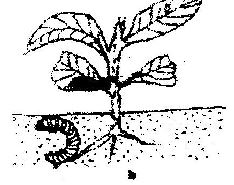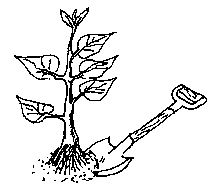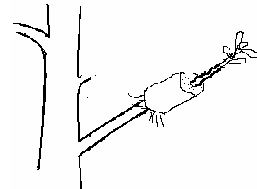INSTRUCTION TO CANDIDATES
- Answer all the questions in sections A and B.
(SECTION A 30 MARKS)
ANSWER ALL QUESTION IN THIS SECTION
- List down any two branches of Agriculture. (1mk)
- Name the three primary macronutrients (1½mks)
- Name four common daily cattle breeds in Kenya (2mks)
- List four methods of fertilizer application (2mks)
- Name four tertiary operations during land preparations (2mks)
- Outline three causes of blossom end rot in tomatoes (3mks)
- Name two method of layering (2mks)
- Name four post harvesting practices infield crops (2mks)
- Name two methods used in pruning of coffee (1mk)
- List down two reasons for earthing up in carrots (2mks)
- Name two methods used in coffee pruning (2mks)
- What do you understand by the following terms as used in nursery practices (2mks)
- Pricking out
- Hardening off
- Name three factors that determine the stage of harvesting in crops (1½mks)
- Outline two qualities of a good grain store (2mks)
- Why is use of manure discouraged when planting carrots (1mks)
- Highlight two qualities of plants used in preparation of green manure (2mks)
- Name two abiotic factors that influence Agriculture (1mks)
(SECTION B 20 MARKS)
Answer All Questions In This Section - The diagram below shows a cabbage crop invested by a pest. Study it carefully then answer the questions that follow.
- Identify the pest. (1mk)
- What damage does the pest cause the crop? (1mk)
- State two methods of controlling the pest (2mks)
- Name any two diseases that attack cabbage in the field. (2mks)
- The diagram below shows a practice carried out in the nursery. Study it carefully then answer the questions that follow.
- Identify the practice (1mk)
- Name the garden tool shown used in carrying out the practice (1mk)
- At what stage should the practice be carried out in vegetable seedlings? (3mks)
- Explain why the nursery should be watered thoroughly before carrying out the practice (1mk)
- Below is an illustration carried out in vegetative crop propagation. Use it to answer the questions that follow.
- Identify the method crop propagation illustrated (1mk)
- Under what circumstances is the method preferred to the other methods (1mk)
- Name three other type of the illustration method that can be used in crop propagation. (3mks)
- A famer was advised to apply 150kg CAN while top dressing his maize field. CAN contain 21% nitrogen. Calculate the amount of Nitrogen applied per/ha. (3mks)
(SECTION C 30 MARKS)
ANSWER ANY TWO QUESTIONS IN THIS SECTION
-
- Discuss on the importance of organic mulching in crops (10mks)
- What are the advantages of using seeds as planting materials (5mks)
-
- Describe five nursery management practices (10mks)
- Describe any five types of vegetables giving an example in each case (5mks)
-
- Discuss on tomato production under the following sub headings
- Varieties (2mks)
- Field management practices (8mks)
- Outline any five factors that determine spacing in crops during planting (5mks)
------ When we wake up every morning, we have two simple choices-------
‘’Go back to sleep and dream or wake up and chase those dreams.”
- Discuss on tomato production under the following sub headings
MARKING SCHEME
(SECTION A 30 MARKS)
- List down any three branches of Agriculture. (3mks)
- Agricultural economics
- Agricultural engineering
- Crop production
- Livestock production
- Soil science
- Name three primary macronutrients (3mks)
- Nitrogen
- Phosphorus
- Potassium
- Name four common daily cattle breeds in Kenya (2mks)
- Friesian
- Jersey
- Guernsey
- Ayrshire
- State four method of fertilizer application (3mks)
- Foliar spray
- Placement method
- Drip application
- Broadcasting
- Tertiary operations during land preparations (2mks)
- Ridging
- Sub-soiling
- Leveling
- Rolling.
- Causes of blossom end rot in tomatoes
- Too much nitrogen in the early stages of growth, irregular watering and calcium deficiency
- Name three method of layering (3mks)
- Marcotting/aerial layering, trench layering, tip layering, sapentive/multiple layering
- State four importance of budding and grafting (4mks)
- Plants with desirable root characteristics but with undesirable products may be used to produce desirable products for example lemon-orange graft.
- They facilitate the changing of the top of the tree from being undesirable to desirable.
- They make it possible to grow more than one type of fruit or flower on the same plant.
- They help to propagate clones that cannot be propagated in any other way. They help to shorten the maturity period.
- Name two methods used in pruning of coffee (1mk)
- Single stem pruning and multiple stem pruning.
- Write down two conditions that show that seedlings are ready for transplanting (2mks)
- 3-4 weeks old
- 10- 15 cm tall
- 4-six leaves
- Name two methods used in coffee pruning (2mks)
- Single stem pruning
- Multiple stem pruning
- What do you understand by the following terms as used in nursery practices (2mks)
- Pricking out
- Removal of excess seedlings from the nursery bed
- Hardening off
- Preparing the seedlings to adapt to the ecological conditions in the seedbed
- Pricking out
- Name four factors that determine the stage of harvesting in crops (4mks)
- Stage of maturity of the crops.
- Use of the crop.
- Tastes and preferences of consumers.
- Weather conditions, hence liability to spoilage.
- Moisture content
- Outline three qualities of a good grain store (3mks)
- It should be clean.
- It should be well ventilated.
- It should be raised from the ground to prevent damp conditions.
- It should be dry.
- It should be strong to hold crop produce.
- It should be easy to clean.
- It should be vermin-proof.
- It should be secure from theft.
- It should be treated against pests such as weevils.
- Define the term opportunity cost as used in Agriculture economics (1mks)
- Returns from the best forgone alternative
- Highlight qualities of plant used in preparation of green manure (4mks)
- Have fast growth rates.
- Have high nitrogen content.
- Capable of rotting quickly.
- Capable of growing in poor conditions.
- Name two abiotic factors that influence Agriculture (2mks)
- Temperature
- Rain
- Relative humidity
- Wind, etc
SECTION B 20 MARKS
-
- Cut worm
- Damage caused by cut worm: Cuts the stem at the base after transplanting.
- Control of cut worms :
- Use of appropriate powder insecticide.
- Crop rotation
- Field hygiene
- Diseases that attack cabbages in the field
- Downy mildew
- Black rot
-
- Practice: Lifting of seedling
- Garden tool used in lifting: Garden trowel
- Stage of transplanting
- 3 to 4 weeks old
- when they have 4 to 6 true leaves
- when they are 10 to 15cm in height
- Reason for watering nursery before lifting of seedlings
- To enhance lifting of seedlings with a ball of soil around the roots, to prevent damaging of the root
-
- Method of layering: Marcotting/Aerial layering
- Circumstances is the method preferred to the other methods: When the branch cannot be bent to the ground.
- Other types of layering: Trench layering, tip layering and compound/serpentive layering
(SECTION C 30 MARKS)
-
- Discuss the importance of organic mulching in crops (10mks)
- Prevents water evaporation thus maintaining moisture in the soil for crop use.
- Acts as an insulator thus modifying the soil temperature.
- It helps to control soil erosion.
- It controls weeds by suppressing them.
- After decomposition organic mulch add nutrients to the soil thus improving its fertility.
- Humus produced after the decomposition of organic mulch improves soil structure and the water holding capacity of the soil.
- Advantages of using seeds as planting materials.
- Seeds are easily treated against soil borne pests and diseases.
- They are not bulky therefore storage is easy.
- They are easy to handle during planting making operation easy.
- When planting seeds, it is easy to use machines like seed planters and drillers.
- It is easy to apply manures and fertilizers together with seeds during planting.
- Fertilizers and manures application can be easily mechanized.
- It is possible to develop new crop varieties due to cross pollination.
- Discuss the importance of organic mulching in crops (10mks)
-
- Nursery Management Practices:
- These are the practices carried out in the nursery while the planting materials are growing.
They include: - Mulching. –light mulch should be applied on the nursery bed .It be should be removed on the 4th day
- Weed control.
- Shading.
- Pricking out.
- Pests and disease control.
- Hardening off
- Watering.
- These are the practices carried out in the nursery while the planting materials are growing.
- Describe any five types of vegetables giving an example in each case.
- Leaf vegetables for example kales and cabbages.
- Root vegetables for example carrots, beets, radishes and turnips.
- Fruit vegetables for example French beans and okra.
- Stem vegetables for example asparagus, leeks and spring onions.
- Bulb vegetables for example bulbed onions and garlic.
- Nursery Management Practices:
-
-
- Tomato Varieties
Fresh market varieties:- Money maker,
- Marglobe, hundred fold,
- Beef eater,
- Hot set,
- Super marmande
- Ponderosa.
Processing varieties: - Kenya beauty,
- San -marzano,
- Roma, ,
- Primabel,
- Rutgers hybrid
- Cal- J.
- Field Maintenance
- Early control of weeds is necessary.
- Top dressing is done after crop establishes.
- Pruning and staking are done to train the plants to grow vertically.
- Pests Controls
- American Bollworm
- Nature of damage: boring holes on the fruits.
- Control: spraying insecticides.
- Tobacco White Fly
- Nature of damage: suck plant sap from the underside of the leaf, hence may transmit viral diseases.
- Control: Destroy infected plant and spray insecticides.
- American Bollworm
- Disease Control
- Late Blight
- Cause: Fungus
- Symptoms: dry patches on the leaves and fruits.
- Control: use of fungicides, crop rotation and destruction of affected materials.
- Blossom-end Rot
Caused by;- Too much nitrogen in early stages.
- Irregular or infrequent watering.
- Calcium deficiency.
Control: Apply calcium ammonium nitrate and correction of the above problems
- Late Blight
- Pests Controls
- Tomato Varieties
- Explain any five factors that that determine spacing in crops during planting (10mks)
- The type of machinery to be used - The space between the rows should allow free passage of the machinery which can be used in the field. For example, the spacing between rows of coffee is supposed to allow movement of tractor drawn implements.
- Soil fertility - A fertile soil can support high plant population. Therefore closer spacing is possible.
- The size of plant - Tall crop varieties require wider spacing while short varieties require closer spacing, for example, Kitale hybrid maize is widely spaced than Katumani maize.
- Moisture availability - Areas with higher rainfall are capable of supporting a large number of plants hence closer spacing than areas of low rainfall.
- Use of crop - Crop grown for the supply of forage or silage material is planted at a closer spacing than for grain production.
- Pest and diseases control - When crops are properly spaced, pests might find it difficult to move from one place to the other, for example, aphids in groundnuts.
- Growth habit - Spreading and tillering crop varieties require wider spacing than erect type
-
Download Agriculture Questions and Answers - Form 2 Mid Term 3 Exams 2023.
Tap Here to Download for 50/-
Get on WhatsApp for 50/-
Why download?
- ✔ To read offline at any time.
- ✔ To Print at your convenience
- ✔ Share Easily with Friends / Students




